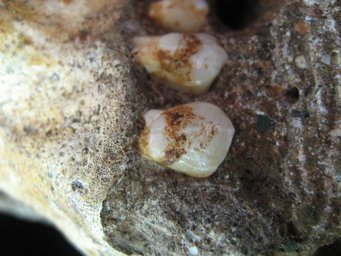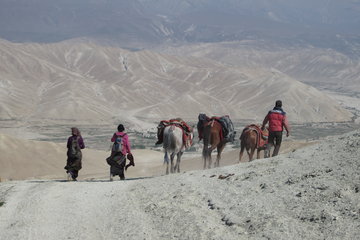Australopithecus sediba had plant foods on the menu
For the first time, researchers have found plant remains in the two-million-year-old dental plaque of ancient hominins’ teeth
The first direct evidence of what our earliest ancestors actually ate has been discovered due to a two-million-year-old mishap that befell two early members of the human family tree. Amanda Henry of the Max Planck Institute for Evolutionary Anthropology in Leipzig, Germany, and co-workers determined the diet of these hominins by looking at patterns of dental wear and analysing tiny plant fragments on their teeth. The authors also consider carbon-isotope data derived from the skeletons, which can indicate the types of carbon source that were eaten. Notably, bark and woody tissues were found in the teeth of the two individuals; this has not been documented previously for hominins. The findings indicate that Australopithecus sediba had a diet that is somewhat unexpected compared with the diets of similarly aged early African hominins. The study was led by Professor Lee Berger of the University of the Witwatersrand in Johannesburg, South Africa.

Almost two million years ago, an elderly female and young male of the species Australopithecus sediba fell into a sinkhole, where their remains were quickly buried in sediment. In 2010, palaeoanthropologist Lee Berger of the University of the Witwatersrand in Johannesburg, South Africa, and his colleagues described the remains of this newly described hominin. Now the international team of scientists has studied the teeth of these specimens, which proved to have unique properties because of how the hominins died.
The team comprised nine scientists from across the globe. Lead author was Amanda Henry of the Max Planck Institute for Evolutionary Anthropology in Germany, a specialist in dental calculus and plant remains. Other specialists on the multi-disciplinary team included dental microwear specialists, isotopic specialists and phytolith researchers - scientists who study the physical remains of ancient plants.
“The find is unprecedented in the human record outside of fossils just a few thousand years old. It’s the first truly direct evidence of what our early ancestors put in their mouths and chewed - what they ate,” said Berger. The research began when he noticed what appeared to be stains on the teeth and realized they were probably dental plaque or calculus, which is mineralized material that forms on teeth.
“We have a very unusual type of preservation,” said Peter Ungar of the University of Arkansas and scientist responsible for the dental microwear studies conducted in the research. “The state of the teeth was pristine.” Since the two individuals were buried underground and quickly encased in sediment, parts of the teeth were even preserved with a pocket of air surrounding them.
Because of this, the researchers were able to perform three different types of analysis on the fossils. Dental microwear analyses of the tooth surfaces and high-resolution isotope studies of the tooth enamel were conducted on these remarkably well-preserved teeth. The teeth also harboured another thing not studied before in early hominins – areas of preserved plaque build-up around the edges of the teeth. In this plaque the scientists found phytoliths, small silica bodies from plants eaten almost two million years ago by these early hominins.
“It’s the first time we’ve been able to look at these three things in one or two specimens,” Ungar said. Henry adds that “We hope this study provides an inspiration for similar interdisciplinary studies in the future. We've been very lucky to bring together such a diverse group of talented researchers.”
Using isotope analysis, dental microwear analysis and phytolith analysis, the researchers closed in on the diet of these two individuals, and what they found differs from other early human ancestors from that period. The microwear on the teeth showed more pits and complexity than most previously studied australopiths. Like the microwear, the isotopes also showed that the animals were consuming mostly parts of trees, shrubs or herbs rather than grasses.

The phytoliths gave an even clearer picture of what the animals were consuming, including bark, leaves, sedges, grasses, fruit and palm. Tests were conducted on the surrounding sediments to ensure the samples from the plaque were really part of the diet, and not contamination. “By testing the sediments in which the hominid was buried we can be sure that the phytoliths in the calculus were not from post depositional contamination,” said Marion Bamford of the University of the Witwatersrand, who worked on the phytolith analysis.
“Personally, I found the evidence for bark consumption the most surprising,” said Berger, “while primatologists have known for years that primates, including apes, eat bark as a fall-back food in times of need, I really hadn’t thought of it as a dietary item on the menu of an early human ancestor.”
Matt Sponheimer of the University of Colorado, Boulder, who worked on the isotopic research, elaborated on the importance of their results: “What we did was see what this ancient carbon told us about the diets of the Malapa hominins through a sort of laser dentistry, but with long-dead patients. The results suggested a different diet than we have found in other early hominins, and were rather like what we find in living chimpanzees. We were not expecting sediba to look unlike Australopithecus and Homo as various researchers had suggested affinities to one genus or the other, or both.”
Ungar adds “We get a sense of an animal that looked like it was taking advantage of forest resources”. This kind of food consumption differs from what had been seen in evidence from other australopiths. “They come out looking like giraffes in terms of their tooth chemistry. A lot of the other creatures there were not eating such forest resources.”
“These findings tell us a really interesting story about these two individuals,” Ungar said. Berger adds “To think that we have direct evidence of what these near humans put in their mouths and chewed, still preserved in their mouths after two million years. it is pretty remarkable.”
####
Lee Berger of the University of the Witwatersrand led the project. Amanda Henry of the Max Planck Institute in Leipzig, Germany; Marion Bamford of the University of the Witwatersrand; and Lloyd Rossouw of the National Museum Bloemfontein in South Africa conducted the analysis of the phytoliths. Peter Ungar conducted the microwear analysis. Benjamin Passey of Johns Hopkins University; Matt Sponheimer and Paul Sandberg of the University of Colorado at Boulder; and Darryl de Ruiter of Texas A&M conducted the isotope analysis.
WITS, SJ













